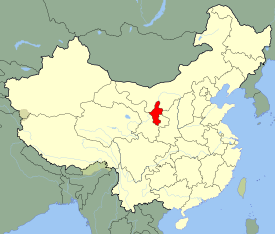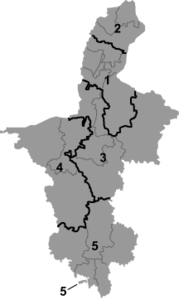Ningxia
| Ningxia Hui Autonomous Region | |||||||||
|
|||||||||
| Abbreviations: 宁 (pinyin: Níng) | |||||||||
 |
|||||||||
| Origin of name | 宁 níng—tranquil 夏 xià—Western Xia "Tranquil Xia" |
||||||||
| Administration type | Autonomous region | ||||||||
| Capital (and largest city) |
Yinchuan | ||||||||
| CPC Ctte Secretary | Chen Jianguo | ||||||||
| Chairman | {{{Governor}}} | ||||||||
| Area | 66,000 km2 (25,000 sq mi) (27th) | ||||||||
| - Latitude | {{{Latitude}}} | ||||||||
| - Longitude | {{{Longitude}}} | ||||||||
| Population (2009) - Density |
6,220,000 (29th) 89.1 /km2 (231 /sq mi) (25th) |
||||||||
| GDP (2009) - per capita |
CNY 133.47 billion (29th) CNY 21,470 (18th) |
||||||||
| HDI (2006) | 0.737 (medium) (25th) | ||||||||
| Ethnic composition | Han: 62% Hui: 34% Manchu: 0.4% |
||||||||
| Prefecture-level | 5 divisions | ||||||||
| County-level | 21 divisions | ||||||||
| Township-level* | 219 divisions | ||||||||
| ISO 3166-2 | CN-64 | ||||||||
| Official website http://www.nx.gov.cn/ |
|||||||||
| Source for population and GDP data:
《中国统计年鉴—2005》 China Statistical Yearbook 2005
Source for nationalities data:
ISBN 7503747382 《2000年人口普查中国民族人口资料》 Tabulation on nationalities of 2000 population census of China
*As at December 31, 2004ISBN 7105054255 |
|||||||||
| Template ■ Discussion ■ WikiProject China | |||||||||
Ningxia (simplified Chinese: 宁夏; traditional Chinese: 寧夏; pinyin: Níngxià; Wade–Giles: Ning-hsia; Postal map spelling: Ningsia), full name Ningxia Hui Autonomous Region (simplified Chinese: 宁夏回族自治区; traditional Chinese: 寧夏回族自治區; pinyin: Níngxià Huízú Zìzhìqū), is a Hui autonomous region of the People's Republic of China, located on the northwest Loess highland, the Yellow River flows through a vast area of its land. The Great Wall of China runs along its northeastern boundary. Ningxia is the home of the Hui, one of the officially recognized Nationalities of China. The capital of the region is Yinchuan.
Ningxia is bounded by Shaanxi and Gansu provinces and Inner Mongolia autonomous region and has an area of 66,400 km2. Formerly a province, Ningxia was incorporated into Gansu in 1954 but was detached and reconstituted as an autonomous region for the Hui people in 1958. In 1969, Ningxia received a part of the Inner Mongolian Autonomous Region, but this area was returned in 1979. It is nearly coextensive with the ancient kingdom of the Tangut people, whose capital was captured by Genghis Khan in the early 13th century.
Ningxia is mostly desert and is sparsely settled, but the vast plain of the Yellow River in the north has been irrigated for centuries; over the years an extensive system of canals has been built. Desert and grazing land make up most of the area. Extensive land reclamation and irrigation projects have increased cultivation. The northern section, through which the Yellow River flows, is the best agricultural land. A railroad, linking Lanzhou with Baotou, crosses the region. A highway has been built across the Yellow River at Yinchuan.
Contents |
History
Ningxia and its surrounding areas were incorporated into the Qin Dynasty as early as the third century BCE. Throughout the Han Dynasty and the Tang Dynasty there were several large cities established in the region, and by the eleventh century the Tangut tribe had established the Western Xia Dynasty on the outskirts of the then Song Dynasty.
It then came under Mongol domination after Genghis Khan conquered Yinchuan in the early thirteenth century. After the Mongols departed and its influences faded, some Turkic-speaking Muslims also began moving into Ningxia from the west. The Muslim Rebellion of the 19th century occurred here.
In 1914, Ningxia was merged with the province of Gansu; in 1928, however, it was detached and became a province. Between 1914 and 1928, the Xibei San Ma brothers (literally "three Mas of the northwest") ruled the provinces of Qinghai, Ningxia and Gansu. In 1958, Ningxia formally became an autonomous region of China. In 1969, Ningxia's border was extended to the north and acquired parts of the Inner Mongolia autonomous region, but was reverted again in 1979.
Geography
Ningxia borders the provinces of Shaanxi and Gansu, and the Inner Mongolia Autonomous Region.
Rivers that flow through Ningxia include the Yellow River. The Ningxia ecosystem is one of the least studied regions in the world. Some plant genii in Ningxia have been estimated at over 40,000 years old.
Ningxia is a relatively dry, desert-like region. There is significant irrigation in order to support the growing of wolfberries (a commonly consumed fruit throughout the region).
Ningxia's deserts include the Tengger desert in Shapotou.
On 16 December 1920, the Haiyuan earthquake, 8.6 magnitude, at , initiated a series of landslides that killed an estimated 200,000 people. Over 600 large loess landslides created more than 40 new lakes.[1][2]
In 2006, satellite images indicated that a 700 by 200-meter fenced area within Ningxia—5 km southwest of Yinchuan, near the remote village of Huangyangtan—is a near-exact 1:500 scale terrain model reproduction of a 450 by 350-kilometer area of Aksai Chin bordering India, complete with mountains, valleys, lakes and hills. Its purpose is as yet unknown.[3][4]
| History of Islam in China |
|
History |
| Major figures |
|
Lan Yu • Yeheidie'erding |
| Culture |
|
Cuisine • Martial arts |
| Cities/Regions |
| Groups |
|
Hui • Uyhgurs • Panthays |
Climate
The region is 1,200 km from the sea and has a continental climate with average summer temperatures rising to between 17 and 24°C in July and average winter temperatures dropping to between -7 and -10°C in January. Seasonal extreme temperatures can reach 39°C in summer and -30°C in winter. The diurnal temperature variation in summer is 17°C. Annual rainfall averages from 190 to 700 millimeters, with more rain falling in the south of the region.
Environment
Governance
The politics of Ningxia is structured in a dual party-government system like all other governing institutions in mainland China.
The Chairman of the Autonomous Region is the highest ranking official in the People's Government of Ningxia. However, in the Autonomous Region's dual party-government governing system, the Chairman has less power than the Communist Party of China Ningxia Committee Secretary, colloquially termed the "Ningxia CPC Party Chief".
Ningxia has a friendship agreement with Sogn og Fjordane county of Norway.[5]
Administrative divisions
Ningxia is divided into five prefecture-level cities:
| Map | # | Name | Hanzi | Hanyu Pinyin | Administrative Seat |
|---|---|---|---|---|---|
 |
|||||
| 1 | Yinchuan | 银川市 | Yínchuān Shì | Xingqing District | |
| 2 | Shizuishan | 石嘴山市 | Shízuǐshān Shì | Dawukou District | |
| 3 | Wuzhong | 吴忠市 | Wúzhōng Shì | Litong District | |
| 4 | Zhongwei | 中卫市 | Zhōngwèi Shì | Shapotou District | |
| 5 | Guyuan | 固原市 | Gùyuán Shì | Yuanzhou District |
Economy
Ningxia is the province with the third smallest GDP (Tibet being the last) in the PRC. Its nominal GDP in 2008 was just 133.46 billion yuan (US$19.5 billion) and a per capita GDP of 21,470 yuan (US$3,143). It contributes 0.3% of the national economy.
Ningxia is the principal region of China where wolfberries are grown.
Yinchuan Economic and Technological Development Zone:[6] established in 1992 spanning 32 km2, annual economic output Rmb23.7 billion (25.1% up) (US$3.5 billion) Major investors: Mainly local enterprises such as Kocel Steel Foundry, FAG Railway Bearing (Ningxia), Ningxia Little Giant Machine Tools, etc. Major industries: Machinery and equipment manufacturing, new materials, fine chemicals and the animation industry
Desheng Industrial Park (in Helan County), is a base for about 400 enterprises. The industrial park has industrial chains from Muslim food and commodities to trade and logistics, new materials and bio-pharmaceuticals that has 80 billion yuan in fixed assets. Desheng is looking to be the most promising industrial park in the city. It achieved a total output value of 4.85 billion in 2008, up 40 percent year-on-year. The local government plans to cut taxes and other fees to reduce the burden on local enterprises. The industrial output value reached 2.68 billion yuan in 2008, an increase of 48 percent from a year earlier.
Transport
Airports
- Yinchuan Hedong Airport (银川河东机场)
- Yinchuan Helanshan Airport (银川贺兰山机场)
- Zhongwei Xiangshan Airport (中卫香山机场)
- GuYuan Airport(固原机场) (Constructing(建设中))
- Wuhai Airport (serves the northern area)
Highways
- China National Highway 109
- China National Highway 110
- China National Highway 211
- China National Highway 307
- China National Highway 309
- China National Highway 312
Bridge
- Taole Yellow River Expressway Bridge (陶乐黄河大桥)
Rail
- Baotou-Lanzhou Railway (包兰铁路)
- Baozhong Railway (宝中铁路)
Universities
See List of universities and colleges in Ningxia
Hospitals
- People's Hospital of Ningxia
- Hospital of Traditional Chinese Medicine of Ningxia
- Ningxia Medical College affiliated Hospital
- Yinchuan Hospital of Traditional Chinese Medicine
- Yinchuan People's Hospital
- Yinchuan Stomatological Hospital
- Yinchuan Women and Children's Healthcare Center
- Women and Children's Healthcare Center of Ningixa
- Yinchuan No.1 People's Hospital
- Yinchuan No.2 People's Hospital
- Yinchuan No.3 People's Hospital
- Shizuishan No.2 People's Hospital
- Guyuan Hospital of Ningxia
Tourism
One of Ningxia's main tourist spots is the famous Xixia Tombs site located 30 km west of Yinchuan. The remnants of nine Western Xia emperors' tombs and two hundred other tombs lie within a 50-km² area. Other famous sites in Ningxia include Helan Shan, the mysterious 108 dagobas, the twin pagodas of Baisikou and the desert research outpost at Shapatou.
Museums
- Ningxia Museum, opened in 1988
- Ningxia Transportation Museum, opened in August 2008
Gallery
 A mosque in Wuzhong |
 Western Xia Tombs |
 From a cable car running to the top of Helan Shan |
Aerial view of Yinchuan |
|
People's Square in Yinchuan |
Fountain in Yinchuan |
The 108 dagobas near Qingtongxia |
 Wolfberry harvest celebration |
Notes
- ↑ Close, U., and McCormick (1922) "Where the mountains walked" National Geographic Magazine 41(5): pp.445–464.
- ↑ Feng, X. and Guo, A. (1985) "Earthquake landslides in China" In Proceedings, IVth International Conference and Field Workshop on Landslides pp. 339–346, Japan Landslide Society, Tokyo, OCLC 70324350.
- ↑ Haines, Lester (19 July 2006)."Chinese black helicopters circle Google Earth". The Register
- ↑ Cassidy, Katherine (13 September 2006). "Armchair Sleuths Uncover Strange Military Sites in China". McClatchy Newspapers / Real Cities Network.
- ↑ Ningxia og Sogn og Fjordane eit steg vidare på samarbeidsvegen
- ↑ http://www.ycda.gov.cn - 银川经济技术开发区银川高新技术产业开发区
References
- Economic profile for Ningxia at HKTDC
- Profile of Ningxia at china.org.cn
- Ningxia 2004 - The Year in Review
- Ningxia 2005 - The Year in Review
- Ningxia Profile - UNESCAP
- Ningxia Center for the Environment and Poverty Alleviation
- Ningxia Profile - China Economic Information Network
- Ningxia (autonomous region, China) -- Britannica Online Encyclopedia
External links
- Ningxia Provincial Government
- Ningxia Agricultural Information Network
- Ningxia Investment Promotion Bureau
- Britnannica Ningxia
- Ningxia travel guide from Wikitravel
|
|||||||||||||||
|
|||||||||||||||||||

